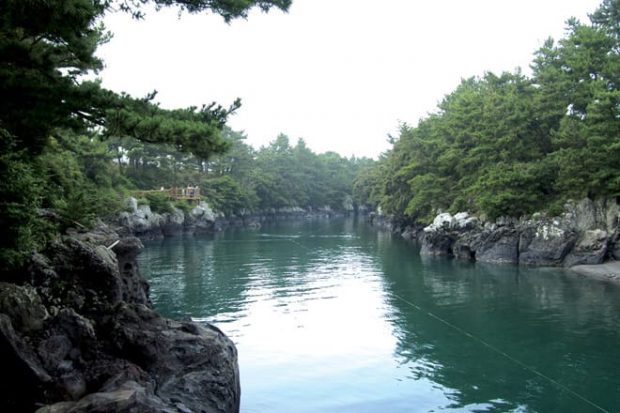
Jeju island: Rocks, Wind and Haenyo

Jeju City: Jeju-do, Korea’s largest island, has long been the country’s favorite domestic holiday destination thanks to its beautiful beaches, lush countryside, and seaside hotels designed for rest and relaxation. Also thanks to caves, museums, markets and amazing food, the island is full of tourists. It is well known for its natural wonders, including waterfalls, white sand beaches, and a dormant volcano–South Korea´s highest mountain–at the center of the island. Jeju-do, located 64 kilometers south of the Korean Peninsula, is full of parks, gardens, and festivals. The capital of Jeju Island is Jeju city.
Three main components are associated with Jeju: rocks, wind, and haenyeo, the female divers of Jeju-do.
The Jeju people of old made use of rocks just lying about and made walls that would block strong winds. Dolharubang which is a symbol of Jeju is a stone statue made from the basalt rocks. The second element, wind, invites people to surf. In fact, surfers on the waves is quite a common sight Jeju-do. The last component, haenyeo, is probably the most interesting aspect. The word haenyeo directly translated is “sea woman” and refers to female occupational divers who fish for seafood and seaweed with no exterior breathing apparatus.
Divided into three groups according to their experience (upper class, middle class and lower class), haenyeo learn to control their breathing underwater.
Since 1970, the government has been trying to support the diving women by providing wetsuits and subsidizing medical insurances, but the number of haenyeo continues to decrease with each year. The tools the women use can also be divided into three categories: hand tools (knife, small hoe, and sickle), collection equipment (fisihng net, buoy), and diving-wear. When diving, haenyeo let out a curious sound, sumbi-sori, which is a unique breathing technique and a sign of acknowledging each other’s presence. In 2016, haenyeo were listed as an invaluable cultural heritage of humanity by UNESCO for their contribution to the advancement of women’s status in the community, promoting environmental sustainability with their eco-friendly fishing methods, and for their involvement in the management of fishing practices.
Of course besides these, Jeju overflows with great food and beautiful sites such as Hamdeok Beach, Soesokkak Estuary, and Jeongbang Falls.
Furthermore, Jeju Island Geopark was confirmed as a Global Geoparks Network member on October 4, 2010. A Geopark is “A territory encompassing one or more sites of scientific importance, not only for geological reasons but also by virtue of its archaeological, ecological or cultural value,” according to the UNESCO Geoparks International Network (GGN) of Geoparks programme. The GGN program aims at enhancing the value of sites representing an earth science interest while at the same time creating employment and promoting regional economic development. The UNESCO Geopark Program works in synergy with UNESCO’s World Heritage.
Although the new coronavirus from China has reduced people’s visits, spring on Jeju Island, filled with rape blossoms, welcomes tourists.


